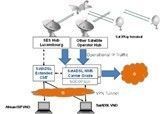
-
StatusCompleted
-
Status date2014-11-14
“SatFinAfrica” is a pilot project to demonstrate the suitability of the Sat3Play platform, originally designed for the consumer and SoHo market, to provide reliable and secured financial services (e.g. to money transfer companies, microfinance institutions, banks and Automated Teller Machines) in remote and underserved areas in emerging countries in Africa.
SatFinAfrica targets remote sites of large organisations, in particular financial institutions, which have a critical need for a ubiquitous and secured telecommunication platform with adequate latency performance and privacy and acceptable service costs. Not covered by terrestrial communications means, these remote sites are generally not large enough to justify the investment in a classic corporate VSAT.
Two main financial applications are targeted:
- Money Transfer . The main requirements for the Money Transfer application are:
- VoIP,
- Latency < 700ms,
- Need for prioritisation of the traffic to allow money transfer applications and banking applications to have priority over office applications (e.g. e-Mails).
- Automatic Telling Machines (ATMs). The main requirements for the ATM application are:
- Closed Users Group,
- Need for a Committed Information Rate (CIR) of 10kbps to allow reliable authentication/authorisation of transactions,
- Latency <800-900ms,
- Privacy.
In addition, SatFinAfrica also targets the development and provision of VNO (Virtual Network Operator) and QoS features for the Sat3Play platform to allow local distributors to autonomously manage the service profiles of their pools of customers and become, de-facto, local service operators.
This is supported by the development of a Monitoring&Controlling tool (CMT, Customer Management Tool), which provides a user-friendly web-interface with different levels of rights to grant local distributors the required level of autonomy and ease of usage.
In broad terms, the scope of the original project activity and the CCN#1 activities was to enhance the current SES Broadband service in a context where SES manages all the satellite IP traffic and configures standard "volume-based" or "FUP-Based" services for its customers.
Having fully met the above objectives, the on-going CCN#2 activities aim at enhancing the current service platform so that SatADSL (the new Belgian service provider created thanks to the above achievements) can:
- Autonomously manage its own IP traffic and configure new categories of services, including contended and dedicated services,
- Allow African service providers to configure their own services with their own users and become, de-facto, local virtual service operators.
Microfinance companies are usually very reluctant to subscribe to new services until they are fully convinced that the solution meets their needs in terms of ease of usage, reliability and affordability.
Therefore, the pilot stages have to achieve the above goals as from the very first trials, not to lose the “momentum” with the potential buyers of the service.
Thanks to the provision of VNO and QoS features, together with user-friendly tools allowing local African distributors to easily and autonomously manage their pool of users, SatADSL aims at significantly increasing their already growing pool of customers among finance organisations all over Africa.
The migration from the CCM to the ACM platform, together with the High Data Rate services available through off-the-shelf antennas, is also expected to favour the market penetration of SatADSL.
The following developments and activities are covered by the CCN#2 activities:
- Development, deployment and testing of Operational Carrier Grade NMS (Network Management System) with extended CMT and QoS features
In order to be used in operational services, the NMS requires to be “Carrier Grade” (i.e. extremely reliable). The label “Carrier Grade” indicates that the system is resilient to the failure of one of its components. Such resilience includes the redundancy of key hardware components and the ability of the software suite using such hardware to switch to the stand-by component in virtually no time and without losing any information.
The work proposed in this activity of CCN#2 is aimed at:
- Upgrading the NMS developed in the frame of CCN#1 and making it Carrier Grade,
- Enhancing the NMS to support VNO and QoS features,
- Extending the CMT features to manage the VNO and QoS features via a user-friendly web interface with several levels of user profiles.
Figure 1: Operational Carrier Grade Network Management System (NMS) with Extended CMT and QoS features
- Migration of SatFinAfrica users from the CCM to the ACM Hub
The results of the SatFinAfrica pilots and the evidence of the pre-commercial operations on the Adaptive Coding and Modulation (ACM) platform on ASTRA4A satellite performed during the CCN#1 activities, show that such a platform offers a significant number of improvements in terms of bit/Hz efficiency and satellite visibility (i.e. better elevation of the user antenna) compared to the current Constant Coding and Modulation (CCM) platform on Telstar 11N satellite.The work proposed in this activity of CCN#2 is aimed at migrating about 110 user terminals of paying customers from the CCM to the ACM platform.
- High data rate (HDR) Pilot
The newly available Newtec MDM3100 modem offers a revolutionary possibility to the Sat3Play service operator: the possibility to use standard off-the-shelf BUC and antennas from another manufacturer. This allows the provision of services using higher data rates, in particular in the return direction, overcoming the current limitation to 256Kbps. The final result will be an extension of the product portfolio, in terms of Customer Premises Equipment (CPE), for the service operator and the geographical mapping of the available services for different configurations of BUC/iLNB and antennas.The work proposed in this activity of CCN#2 is aimed at:
- Verifying on the field the higher data-rates,
- Identifying a set of combinations of most common third party antennas, LNBs and BUCs available off-the-shelf and compatible with the Sat3Play line-up procedures,
- Training of local installers of existing local distributors to get familiar with the new ODUs and modem.
In nutshell, the planning of the SatFinAfrica CCN#2 activities comprises the following:
- An activity of about 8 months for the consolidation of the technical requirements, the design, development and commissioning of the network,
- Followed by about 8 months pilot stage with the involvement of about 30 pilot sites, selected among potential micro-finance institutions interested to subscribe to the service.
The Final Review is planned in July 2014.





